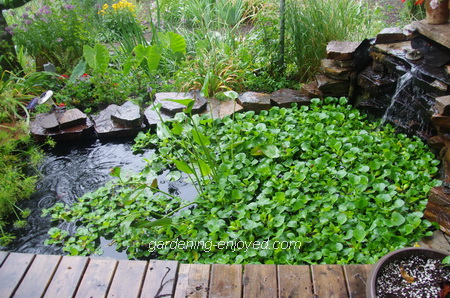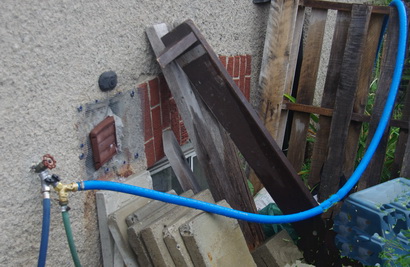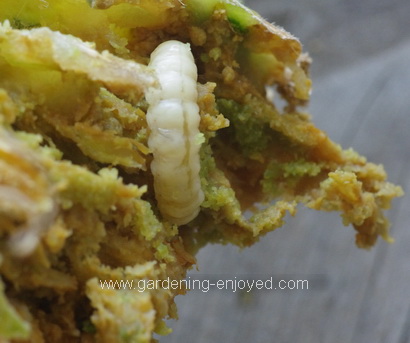
Water Hyacinths have that name because they produce a flower spike that resembles a Hyacinth. That’s what I have been told! Almost 20 years of buying 3 Water Hyacinths each spring and putting them in my ponds. Never a bloom! In warm years like this one they grow rapidly and as of this week they almost completely cover the surface of the top pond. They really are quite lovely and they contribute to the health of the ponds. Their roots absorb a fair bit of crud from the water. If I pull one out and rinse off the roots, it’s amazing how much black crud comes off. The fish also nibble some of the roots to add to their diet. They provide great shade so that the sunlight does not heat the water too much, didn’t work too well this year, but the shade stops the sunlight from promoting the growth of algae. That helps keep the water clear. All things considered they are worth the $10 that they cost in the spring but I really would like to see them bloom, just once. That’s a
gardener’s quest, always wanting something that’s highly unlikely to happen in their part of the world. I’ll go to Florida in January and remind myself of what they look like when they are in bloom.
 We have been waiting for the “blue water” for weeks. You have heard me moan all summer about the lack of rain and the town ripping up our road and some of my garden with it. When they are going to interrupt the water mains, they lay down these bright blue temporary water lines which all the neighbours have referred to as the “blue water.” The good thing about this blue water is that it does not go through our water meters and we see it as free water. They finally attached it to our houses on Friday afternoon. Free water at least all weekend. All of the gardeners immediately started watering our parched gardens. My vegetable garden’s drip irrigation system was on for a “few” hours on Friday night and I was up at 6:00 am this morning to hook up the system in the Asparagus beds. By 10:30 I switched it over to the berm which has only been watered once all summer. Shortly after noon, it started to rain. You can see the drops in the pond picture at the top. I turned off
the free water from the town and watched the free water from Mother Nature, that she has withheld as long as we had to purchase water. Last time I checked she had supplied almost 4 cm (1.5") of that precious liquid. I have at least three more areas of the garden that I was going to water. Is Mother Nature’s contribution sufficient or should I continue to take advantage of the “blue water”? ?
We have been waiting for the “blue water” for weeks. You have heard me moan all summer about the lack of rain and the town ripping up our road and some of my garden with it. When they are going to interrupt the water mains, they lay down these bright blue temporary water lines which all the neighbours have referred to as the “blue water.” The good thing about this blue water is that it does not go through our water meters and we see it as free water. They finally attached it to our houses on Friday afternoon. Free water at least all weekend. All of the gardeners immediately started watering our parched gardens. My vegetable garden’s drip irrigation system was on for a “few” hours on Friday night and I was up at 6:00 am this morning to hook up the system in the Asparagus beds. By 10:30 I switched it over to the berm which has only been watered once all summer. Shortly after noon, it started to rain. You can see the drops in the pond picture at the top. I turned off
the free water from the town and watched the free water from Mother Nature, that she has withheld as long as we had to purchase water. Last time I checked she had supplied almost 4 cm (1.5") of that precious liquid. I have at least three more areas of the garden that I was going to water. Is Mother Nature’s contribution sufficient or should I continue to take advantage of the “blue water”? ?
 Last week I mentioned that whenever somebody asks me a question about bugs or diseases, I suddenly seem to find them in my garden. Behold the Squash Vine Borer, Melitta curcurbitae. A nasty, fat, white, larva that turns the thick stems of my Zucchini plants into mush. I actually prefer my Iris Borers they are at least cannibalistic and eat each other so that only one borer survives in each plant. I found 6 of these things, cosying up, to share my Zucchini plant. A few of my other squash plants are looking a little peaked and I will find out, after all of this wonderful water, if that was the problem or whether I should be going on a borer hunt. Once they have done this much damage to a plant there is no recovery but finding and killing them has a certain satisfaction and it stops them from completing their life cycle. The hope is to stop or at
least reduce their presence in the garden next year. These fat, nasty, larva will turn into pupa that will overwinter in the soil and the adults will hatch from them next June or early July. If it was possible to find and kill them all then, in theory, I would have few if any problems next year. I think that’s wishful thinking but that’s what keeps a gardener going from year to year. Next June I will have made traps. Any yellow bowl or pail filled with water will attract the adults and they will fall into the water and drown.
Last week I mentioned that whenever somebody asks me a question about bugs or diseases, I suddenly seem to find them in my garden. Behold the Squash Vine Borer, Melitta curcurbitae. A nasty, fat, white, larva that turns the thick stems of my Zucchini plants into mush. I actually prefer my Iris Borers they are at least cannibalistic and eat each other so that only one borer survives in each plant. I found 6 of these things, cosying up, to share my Zucchini plant. A few of my other squash plants are looking a little peaked and I will find out, after all of this wonderful water, if that was the problem or whether I should be going on a borer hunt. Once they have done this much damage to a plant there is no recovery but finding and killing them has a certain satisfaction and it stops them from completing their life cycle. The hope is to stop or at
least reduce their presence in the garden next year. These fat, nasty, larva will turn into pupa that will overwinter in the soil and the adults will hatch from them next June or early July. If it was possible to find and kill them all then, in theory, I would have few if any problems next year. I think that’s wishful thinking but that’s what keeps a gardener going from year to year. Next June I will have made traps. Any yellow bowl or pail filled with water will attract the adults and they will fall into the water and drown.
Don’t stop asking me questions. Each thing that appears in my garden frustrates me but makes me that much more knowledgeable and better equipped to help all of my readers. I must admit that’s small comfort some days when I’m standing in the garden watching my squash plants collapse.
Now it’s time to answer a few of my reader’s questions. Don’t forget to check the front page of the Website for frequent short ideas for current gardening activities.
Lise Asks? I am not sure if this is the right place to ask a question:
but I planted 8 cosmos plants, they are beautiful plants but the problem is only one plant is blooming, beautiful red flowers the others, no sight of blooming ???
Ken Answers! I want to help my readers but sometime the question seems unanswerable or there are just too many possibilities. Are they all different colours that will bloom at later dates. Are they in the same location with identical growing conditions.
Tom Asks? My peonies were gorgeous this year. Now that they're finished flowering, I'm not sure when I should trim them back or how much. Also, what's the downside of transplanting them?
Ken Answers! I just let my Peonies grow until my fall cleanup. I might cut some stalks back a bit if they are flopping over other delights.
Transplanting whole plants is difficult, they have huge roots but dividing them and planting big pieces with several eyes, (visible, usually red, buds,) works well. Don't hurry, late September is soon enough.
Valerie Asks? I attended one of your talks and heard about planting potatoes in pots. I used a few of my large pots and planted potatoes. Can you please tell me how do I know when the potatoes are ready to be taken out?
Ken Answers! That's easy. When the tops turn brown and die down.
Now here is an interesting suggestion from Linda and one that I will be sure to try next year.
I enjoy your newsletter very much, and also appreciated hearing you speak in Napanee this Spring at our Annual General Meeting. I have a suggestion for those bothered by squirrels. They were eating my sunflowers a few years ago. I spread some black netting ( the kind you put over fruit trees, or you can use plastic deer fencing in
packages from Walmart) around on the ground at the base of my plants, and I also run some along the top of an old white fence behind my sunflowers. It is important to secure the netting on the ground with a couple of stones or bricks so it does not move out near the grass and get caught in the lawnmower. It is easy to tie it to the top board of the fence, and if it is black, it just seems to disappear. You do have to be careful to not get tangled up in it yourself, but because small mammals like squirrels, groundhogs, and raccoons are afraid of getting their feet tangled up in it, they will stay away. It keeps groundhogs away from my tomatoes, and It also deters feral cats if you have a problem with them trying to live under your porches etc. It works for me ! I just gather up the netting in the fall, when I am doing my garden clean up, and store in the garage. It lasts for several years.
|

 We have been waiting for the “blue water” for weeks. You have heard me moan all summer about the lack of rain and the town ripping up our road and some of my garden with it. When they are going to interrupt the water mains, they lay down these bright blue temporary water lines which all the neighbours have referred to as the “blue water.” The good thing about this blue water is that it does not go through our water meters and we see it as free water. They finally attached it to our houses on Friday afternoon. Free water at least all weekend. All of the gardeners immediately started watering our parched gardens. My vegetable garden’s drip irrigation system was on for a “few” hours on Friday night and I was up at 6:00 am this morning to hook up the system in the Asparagus beds. By 10:30 I switched it over to the berm which has only been watered once all summer. Shortly after noon, it started to rain. You can see the drops in the pond picture at the top. I turned off
the free water from the town and watched the free water from Mother Nature, that she has withheld as long as we had to purchase water. Last time I checked she had supplied almost 4 cm (1.5") of that precious liquid. I have at least three more areas of the garden that I was going to water. Is Mother Nature’s contribution sufficient or should I continue to take advantage of the “blue water”? ?
We have been waiting for the “blue water” for weeks. You have heard me moan all summer about the lack of rain and the town ripping up our road and some of my garden with it. When they are going to interrupt the water mains, they lay down these bright blue temporary water lines which all the neighbours have referred to as the “blue water.” The good thing about this blue water is that it does not go through our water meters and we see it as free water. They finally attached it to our houses on Friday afternoon. Free water at least all weekend. All of the gardeners immediately started watering our parched gardens. My vegetable garden’s drip irrigation system was on for a “few” hours on Friday night and I was up at 6:00 am this morning to hook up the system in the Asparagus beds. By 10:30 I switched it over to the berm which has only been watered once all summer. Shortly after noon, it started to rain. You can see the drops in the pond picture at the top. I turned off
the free water from the town and watched the free water from Mother Nature, that she has withheld as long as we had to purchase water. Last time I checked she had supplied almost 4 cm (1.5") of that precious liquid. I have at least three more areas of the garden that I was going to water. Is Mother Nature’s contribution sufficient or should I continue to take advantage of the “blue water”? ?  Last week I mentioned that whenever somebody asks me a question about bugs or diseases, I suddenly seem to find them in my garden. Behold the Squash Vine Borer, Melitta curcurbitae. A nasty, fat, white, larva that turns the thick stems of my Zucchini plants into mush. I actually prefer my Iris Borers they are at least cannibalistic and eat each other so that only one borer survives in each plant. I found 6 of these things, cosying up, to share my Zucchini plant. A few of my other squash plants are looking a little peaked and I will find out, after all of this wonderful water, if that was the problem or whether I should be going on a borer hunt. Once they have done this much damage to a plant there is no recovery but finding and killing them has a certain satisfaction and it stops them from completing their life cycle. The hope is to stop or at
least reduce their presence in the garden next year. These fat, nasty, larva will turn into pupa that will overwinter in the soil and the adults will hatch from them next June or early July. If it was possible to find and kill them all then, in theory, I would have few if any problems next year. I think that’s wishful thinking but that’s what keeps a gardener going from year to year. Next June I will have made traps. Any yellow bowl or pail filled with water will attract the adults and they will fall into the water and drown.
Last week I mentioned that whenever somebody asks me a question about bugs or diseases, I suddenly seem to find them in my garden. Behold the Squash Vine Borer, Melitta curcurbitae. A nasty, fat, white, larva that turns the thick stems of my Zucchini plants into mush. I actually prefer my Iris Borers they are at least cannibalistic and eat each other so that only one borer survives in each plant. I found 6 of these things, cosying up, to share my Zucchini plant. A few of my other squash plants are looking a little peaked and I will find out, after all of this wonderful water, if that was the problem or whether I should be going on a borer hunt. Once they have done this much damage to a plant there is no recovery but finding and killing them has a certain satisfaction and it stops them from completing their life cycle. The hope is to stop or at
least reduce their presence in the garden next year. These fat, nasty, larva will turn into pupa that will overwinter in the soil and the adults will hatch from them next June or early July. If it was possible to find and kill them all then, in theory, I would have few if any problems next year. I think that’s wishful thinking but that’s what keeps a gardener going from year to year. Next June I will have made traps. Any yellow bowl or pail filled with water will attract the adults and they will fall into the water and drown.